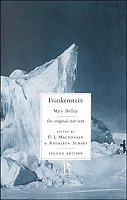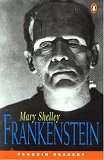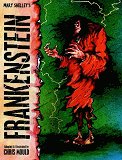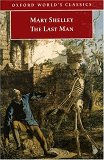
|

 FRANKENSTEIN by Mary Wollstonecraft Shelley (hier online bestellen)
FRANKENSTEIN by Mary Wollstonecraft Shelley (hier online bestellen)
The story:
Captain Walton is sailing in a ship north of the Arctic Circle. Walton's ship becomes
stuck in the ice, and as he contemplates his isolation and paralysis, he spots (perhaps) a figure (which is Victor Frankenstein)
walking across the ice. The narrative of Walton is a frame narrative that allows for the story
of Victor to be related. At the same time, Walton's predicament is symbolically appropriate for Victor's tale
of displaced passion and brutalism.
Curious and intelligent from a young age, Victor Frankenstein leaves his beloved family in Geneva, Switzerland
to study science in Germany. In a moment of inspiration, Frankenstein discovers the means by which inanimate
matter can be imbued with life. With great drive and fervor, he sets about constructing a
creature-intended as a companion, perhaps-from various materials, including cadavers.
He intended the creature to be beautiful, but when the creature awoke, he was disgusted. Its yellow eyes,
rough stitching, large size-Frankenstein found this revolting and although the creature expressed him no
harm (in fact it grinned at him), Frankenstein ran out of the room in terror whereupon the creature
disappeared. Overwork caused Frankenstein to take ill for several months. After recovering, he received a
letter from home informing him of the murder of his youngest brother. He departed for Switzerland at once.
Near Geneva, Frankenstein sees the creature and is convinced it killed his brother. Upon arriving home he
finds Justine, the family's maid, framed for the murder. She is convicted and executed. To recover from the
ordeal, Frankenstein goes to the mountains where he meets his creation atop a glacier.
The creature is strikingly eloquent, and describes his feelings first of confusion, then rejection and hate.
He explains how he learnt how to talk by studying a family through a crack in the wall. He performs in secret
many kind deeds for this family, but in the end, they drive him away when they see his appearance. He gets the
same response from any human who sees him. Wanting revenge, he seeks out Victor, kills his brother, and frames
Justine. But now, the creature only wants one thing; he begs Frankenstein to create a female companion for him.
At first, Frankenstein agrees, but later, he tears up the half-made companion in disgust. In retribution, the
creature kills his best friend. On Frankenstein's wedding night, the creature kills his wife. Frankenstein now
becomes the hunter: he pursues the creature into the arctic ice, though in vain-he dies without managing to
catch him. Finally, the creature finds Frankenstein dead, and greatly laments what he has done to his maker.
The creature vows to commit suicide, and leaves.
Extract from book:
... It was noon when I awoke; and, allured by the warmth of the sun, which shone brightly on the white ground,
I determined to recommence my travels; and, depositing the remains of the peasant's breakfast in a wallet I
found, I proceeded across the fields for several hours, until at sunset I arrived at a village. How miraculous
did this appear! The huts, the neater cottages, and stately houses, engaged my admiration by turns. The
vegetables in the gardens, the milk and cheese I saw placed at the windows of some of the cottages, allured
my appetite. One of the best of these I entered; but I had hardly placed my foot within the door before the
children shrieked, and one of the women fainted. The whole village was roused; some fled, some attacked me,
until, grievously bruised by stones and many other kinds of missile weapons, I escaped to the open country,
and fearfully took refuge in a low hovel, quite bare, and making a wretched appearance after the palaces I
had beheld in the village. This hovel, however, joined a cottage of a neat and pleasant appearance; but,
after my late [recent] dearly bought experience, I dared not enter it. My place of refuge was constructed
of wood, but so low that I could [only] with difficulty sit upright in it. No wood, however, was placed on
the earth, which formed the floor, but it was dry; and although the wind entered it by innumerable chinks,
I found it an agreeable asylum from the snow and rain. .....
About the author:
 Mary Shelley (August 30, 1797 - February 1, 1851)was born in London, England to Mary Wollstonecraft and the
famous atheist William Godwin. She married the poet Percy Bysshe Shelley in 1816 after the suicide of his
first wife.
Mary Shelley (August 30, 1797 - February 1, 1851)was born in London, England to Mary Wollstonecraft and the
famous atheist William Godwin. She married the poet Percy Bysshe Shelley in 1816 after the suicide of his
first wife.
She began work on Frankenstein in 1816 when staying at Lord Byron's villa on Lake Geneva in Switzerland.
She incorporated a number of different sources into her work, not the least being the Promethean myth from
Ovid. The influence of John Milton's Paradise Lost can also be discerned within the novel.
Mary edited and annotated her husband's works after his death in 1822 and also wrote a few more novels,
none of which even begin to approach the fame and lasting power of Frankenstein, with the possible exception
of The Last Man, an intelligent novel of the distant future.
Buchdaten:
FRANKENSTEIN by Mary Wollstonecraft Shelley
Taschenbuch - 392 Seiten - Broadview Pr
Erscheinungsdatum: 1. Dezember 1999
Auflage: 2nd
ISBN: 1551113082
Preis: € 7,90
More works from the same author:
zurück zur Übersicht
|
 FRANKENSTEIN by Mary Wollstonecraft Shelley (hier online bestellen)
FRANKENSTEIN by Mary Wollstonecraft Shelley (hier online bestellen)
 Mary Shelley (August 30, 1797 - February 1, 1851)was born in London, England to Mary Wollstonecraft and the
famous atheist William Godwin. She married the poet Percy Bysshe Shelley in 1816 after the suicide of his
first wife.
Mary Shelley (August 30, 1797 - February 1, 1851)was born in London, England to Mary Wollstonecraft and the
famous atheist William Godwin. She married the poet Percy Bysshe Shelley in 1816 after the suicide of his
first wife.

